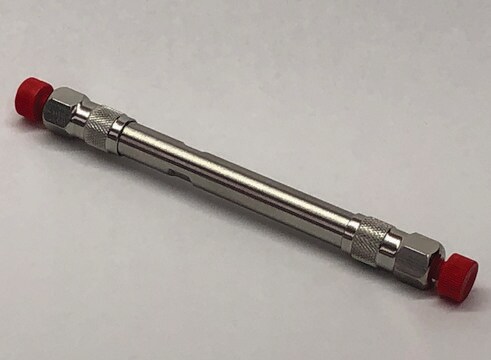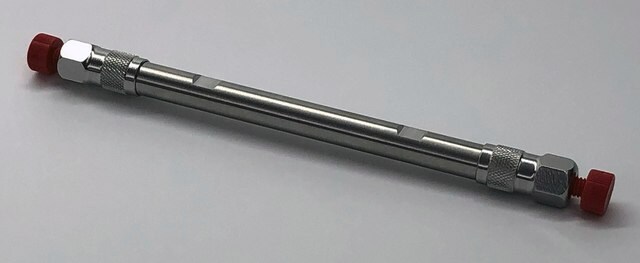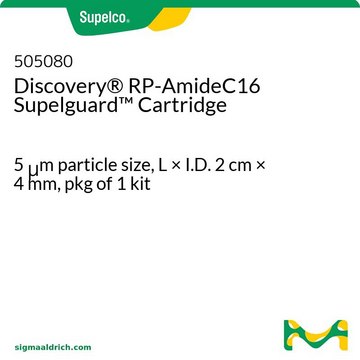565325-U
Ascentis® RP-Amide (5 µm) HPLC Columns
L × I.D. 25 cm × 4.6 mm, HPLC Column
Synonym(s):
RP-Amide Reversed-Phase Chromatography Column
About This Item
Recommended Products
product name
Ascentis® RP-Amide HPLC Column, 5 μm particle size, L × I.D. 25 cm × 4.6 mm
material
stainless steel column
Quality Level
Agency
suitable for USP L60
product line
Ascentis®
feature
endcapped
manufacturer/tradename
Ascentis®
packaging
1 ea of
extent of labeling
19.5% Carbon loading
parameter
≤70 °C temp. range
400 bar pressure (5801 psi)
technique(s)
HPLC: suitable
LC/MS: suitable
L × I.D.
25 cm × 4.6 mm
surface area
450 m2/g
surface coverage
2.7 μmol/m2
impurities
<5 ppm metals
matrix
fully porous particle
silica gel high purity, spherical
matrix active group
amide, alkyl phase
particle size
5 μm
pore size
100 Å
operating pH range
2-8
application(s)
environmental
food and beverages
separation technique
reversed phase
Looking for similar products? Visit Product Comparison Guide
Related Categories
General description
Ascentis RP-Amide is a new generation ultra low bleed, embedded polar group (EPG) phase that provides orthogonal selectivity and increased resolution for HPLC and LC-MS analysis of polar compounds. The Ascentis RP-Amide is the first choice in embedded polar group HPLC phases.
Application
- A validated UHPLC method for the determination of caffeoylquinic and di-caffeoylquinic acids in green coffee extracts using an RP-Amide fused-core column.: This study presents a validated Ultra-High-Performance Liquid Chromatography (UHPLC) method employing an RP-Amide fused-core column for the quantitative determination of caffeoylquinic and di-caffeoylquinic acids in green coffee extracts. The method demonstrated excellent precision, accuracy, and sensitivity, making it a valuable tool for the analysis of these bioactive compounds in complex matrices. The research highlights the utility of the Ascentis® RP-Amide HPLC Column in enhancing the resolution and efficiency of chromatographic separations in analytical chemistry applications (Fibigr et al., 2018).
Features and Benefits
- Excellent retention and peak shape for polar compounds
- 100% aqueous compatibility
- Ultra low bleed, LC-MS compatible
- Unique selectivity
Legal Information
guard cartridge
Storage Class Code
11 - Combustible Solids
WGK
WGK 3
Flash Point(F)
Not applicable
Flash Point(C)
Not applicable
Regulatory Listings
Regulatory Listings are mainly provided for chemical products. Only limited information can be provided here for non-chemical products. No entry means none of the components are listed. It is the user’s obligation to ensure the safe and legal use of the product.
JAN Code
565325-U:
Choose from one of the most recent versions:
Already Own This Product?
Find documentation for the products that you have recently purchased in the Document Library.
Customers Also Viewed
Our team of scientists has experience in all areas of research including Life Science, Material Science, Chemical Synthesis, Chromatography, Analytical and many others.
Contact Technical Service









